Comprehensive Guide to Parakeets: Facts and Care
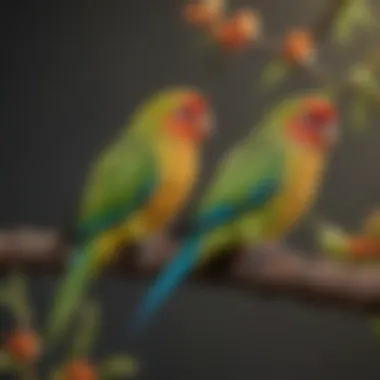
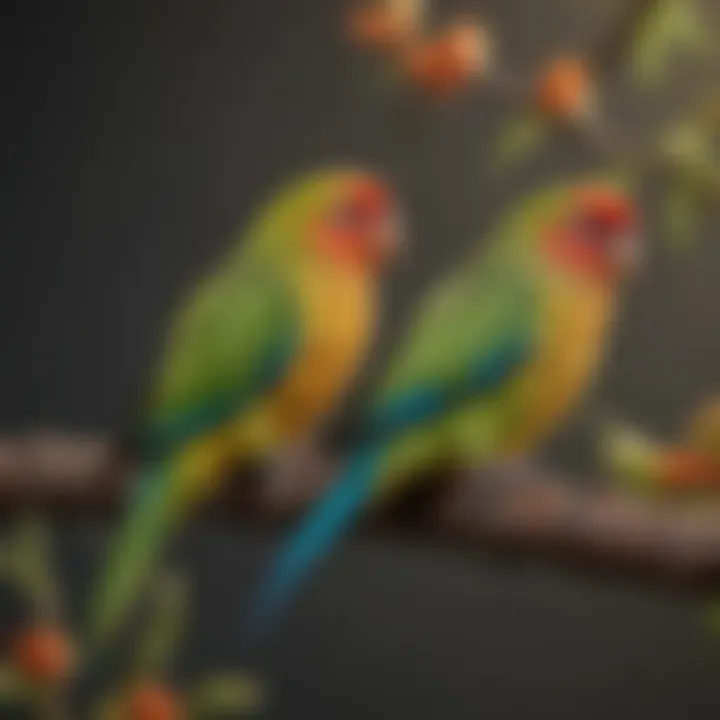
Intro
Parakeets, known for their vibrant colors and cheerful demeanor, have captured the hearts of many bird enthusiasts and casual pet owners alike. Yet, beneath their charming exterior lies an intricate world of behaviors and needs that often go unnoticed. Understanding these feathered companions involves diving deep into their characteristics, care needs, and the unique challenges they present to their caretakers. This journey into the realm of parakeets encompasses everything from their daily routines to the subtleties of their body language.
Care Tips
Daily Care Routines
Taking care of a parakeet isn't just a weekend commitment; it’s an everyday responsibility. Start each morning by refreshing their water and ensuring their food bowl is stocked with fresh seeds or pellets suitable for their species. Additionally, a few minutes of social interaction can go a long way in building trust and bonding. Taking time to observe them daily will help you notice any shifts in behavior that might signal health issues.
Cage Setup and Maintenance
A parakeet's cage serves as both a home and a playground. Aim for a spacious cage where your parakeet can flap its wings fully. Consider including perches of various diameters to promote foot health, and always place the cage in a spot where your bird can engage with household activity. Regular maintenance is key; clean the cage at least once a week to prevent the buildup of droppings and uneaten food.
Hygiene and Cleaning Practices
Cleaning goes beyond the cage; your parakeet’s toys and food dishes should also be cleaned thoroughly. Opt for non-toxic cleaners or simply use warm soapy water. Regularly check for wear and tear on toys, replacing those that show signs of damage to avoid any choking hazards.
Seasonal Care Adjustments
As seasons change, so do a parakeet’s needs. In winter, be mindful of drafts and cold temperatures, which can affect their health. Conversely, during the summer, make sure they have access to fresh water and shade to avoid overheating. Adjusting your routines as needed ensures your parakeet thrives throughout the year.
Behavioral Insights
Understanding Bird Body Language
Parakeets communicate largely through their body movements and vocalizations. A fluffed-up bird might be feeling threatened or unwell, whereas a relaxed stance indicates comfort. Spiraled feathers or head bobbing typically denote curiosity or excitement. Close observation is key to deciphering their moods.
Common Behavioral Issues and Solutions
Like all pets, parakeets can develop behavioral quirks. Feather plucking or excessive vocalization could hint at stress or boredom. Providing a stimulating environment with toys or encouraging social interaction is often effective. Listening to their calls can also help you recognize if they are seeking companionship or simply trying to get your attention.
Positive Reinforcement Techniques
Utilizing rewards is a great way to reinforce desired behaviors. Treats work wonders, but so can praise and attention. Whenever your parakeet successfully uses its perch or learns a new trick, a small treat or enthusiastic chatter will encourage them to repeat that behavior.
Social Interaction Needs
Parakeets thrive on companionship, whether that’s with other birds or their human caregivers. When considering adding another parakeet, take time to properly introduce them to avoid territorial disputes. Routine playtime outside of the cage fosters strong social bonds.
Nutrition Guides
Essential Diet Components
A balanced diet for parakeets includes high-quality pellets, fresh fruits, and vegetables. Nutrient-rich foods are vital for their health. Things like leafy greens, apples, and carrots are often well-received, paying careful attention to what’s safe for their consumption.
Safe and Toxic Foods
Some foods pose serious risks. For instance, avocados and chocolate can be toxic. It’s crucial for any bird owner to learn which foods are beneficial and which could be harmful. Always double-check before introducing a new treat to their diet.
Supplements and Treats
While a varied diet can provide necessary nutrients, certain supplements can help when birds are ill or during stressful times. Calcium supplements, for example, are good for laying hens.
Feeding Strategies for Different Species
Different parakeet species have varying needs. Budgerigars do well on a staple of robust pellets, while more exotic species might require additional nutrients. Consulting with a vet can provide tailored advice.
Wellness and Health
Routine Health Checkups
Just like any pet, parakeets benefit from regular veterinary visits. Schedule them at least once a year to monitor their health and catch potential issues early on.
Identifying Symptoms of Illness
Be vigilant for symptoms like lethargy, changes in appetite, or unusual droppings. Early detection can be crucial to effective treatment.
Preventative Care and Vaccinations
Vaccinations play an essential role in preventing disease. Keep an eye on your parakeet's living conditions—clean and spacious environments often correlate with good health.
Mental and Emotional Well-being
Mental health matters. Parakeets need mental stimulation to prevent boredom; consider rotating their toys regularly or providing training opportunities to keep their intellect engaged.
Enriching Activities
Toys and Playtime Ideas
Diverse toy options cater to their playful natures, from swings to bells to chewable items. Engage their instincts by allowing supervised out-of-cage playtime. This not only provides exercise but also enriches their environment.
Training and Tricks
Teaching simple tricks not only entertains but strengthens the bond between you and your bird. Start with easy commands and gradually increase their difficulty as your parakeet becomes accustomed to following directions.
Outdoor Activities and Interaction
Taking your parakeet outside for a safe flight in an aviary or harness setup can be delightful for both of you. Fresh air and natural surroundings stimulate their senses in invaluable ways.
DIY Projects for Mental Stimulation
Creating homemade toys encourages creativity. Simple items like paper bags filled with fun materials serve, not only to entertain but to stimulate problem-solving skills.
Maintaining a parakeet’s happiness and health is a rewarding journey that enriches both their lives and the lives of their owners.
By diving into the care, behavior, and wellness aspects of parakeets, prospective owners gain a clearer window into these extraordinary creatures, ensuring a rewarding companionship.
Preface to Parakeets
Parakeets are more than just colorful birds that grace our homes with their songs and chatter. They hold a special place in the avian community, known for their playful personalities and intelligence. This introduction lays down the foundation for understanding what makes parakeets unique as pets. It’s crucial to appreciate not just their beauty, but also the commitment required to ensure a thriving life for these delightful creatures.
Understanding the Parakeet
At first glance, one might think parakeets are merely vibrant pets that look good in a cage. However, delve a little deeper, and you’ll find that these birds are astonishingly complex. Parakeets belong to the Psittacidae family, making them relatives of parrots. Their vocal capabilities stem from a highly developed syrinx, which allows them to imitate sounds and even human speech. A parakeet's ability to learn and mimic creates a unique bond between bird and owner.
Essentially, understanding parakeets involves recognizing their social nature. These birds are not solitary creatures by any means; in the wild, they thrive in flocks, often numbering in the hundreds. This flocking behavior extends to their desire for companionship in captivity. A lone parakeet may become bored or depressed, resulting in damaging behaviors like feather plucking. Therefore, potential owners should ponder the social needs of parakeets before deciding to bring one home.
Moreover, parakeets can be categorized into several popular species, like Budgerigars and Indian Ringnecks, each boasting unique attributes and quirks. These variations underline the necessity for prospective bird parents to understand the particular needs and temperaments of the species they wish to adopt.
The Appeal of Parakeets as Pets
When considering a pet bird, parakeets often emerge as prime candidates due to their appealing combination of beauty, intelligence, and engagement.
- Affordability: Parakeets are relatively inexpensive, especially compared to larger parrots. This price point often makes them accessible for individuals or families looking to introduce a feathered friend into their lives.
- Small Size: Their compact size allows for easier housing and care. In comparison to a macaw or an African Grey, a parakeet requires less space and can adapt well to various living environments.
- Vocal Nature: Many bird enthusiasts are captivated by the melodic chatter of parakeets. Their ability to mimic words and sounds can be entertaining, and for those who enjoy interaction, these birds can provide a lively atmosphere.
For anyone considering a pet, it’s essential to think about the daily requirements of these charming creatures. Unlike cats or dogs that can often be left alone, parakeets require interaction, mental stimulation, and a good deal of affection. Understanding how they fit into your life will contribute significantly to a fulfilling and successful bird-owner relationship.
"Owning a parakeet is not just about having a pet; it's about sharing a life full of joy and companionship."
To sum up, parakeets offer a vibrant option for pet lovers who wish to share their lives with a memorable companion. Their social needs and captivating personalities make them a popular choice, and understanding these elements sets the groundwork for a successful ownership experience.


Taxonomy and Classification
Understanding the taxonomy and classification of parakeets is crucial for appreciating their diversity and behavior. This systematic categorization provides insights into their evolutionary relationships and helps us comprehend the various species better. Different classifications help bird owners and enthusiasts identify the characteristics and care needs of parakeets. It’s not just about naming; it's about understanding where each species fits into the broader avian family, which can inform decisions about care and conservation.
Species Overview
Parakeets belong to the family Psittacidae, which is known for its colorful members and strong intelligence. They inhabit a wide range of environments and exhibit diverse personalities and features. Many enthusiasts focus on specific species due to their unique traits or compatibility as pets. For example, the Budgerigar is renowned for its friendly disposition, making it a favorite among pet owners, while the Indian Ringneck is often appreciated for its striking plumage and vocal skills.
Distinct Features of Popular Species
Budgerigar
The Budgerigar, commonly referred to as the budgie, is perhaps the most widely recognized parakeet. One of its standout features is its ability to imitate sounds and speech. This knack for mimicry not only fascinates bird lovers but also fosters a deeper bond between the bird and its owner through interactive communication. Budgies come in a variety of colors, too, from classic green and yellow to vivid blues and whites. They’re small, easily manageable, and adapt well to cage life, making them a beneficial choice for many pet bird owners.
However, due to their sociable nature, they thrive on companionship -- either from humans or other birds. If left alone too often, they might develop behavioral issues like feather plucking or excessive chirping. Thus, their social needs must be balanced carefully with their unique characteristics.
Indian Ringneck
One cannot overlook the Indian Ringneck when discussing popular parakeet species. Known for its vibrant colors and distinct ring around its neck, this bird has become increasingly preferred among avian enthusiasts. They are remarkably intelligent and can learn a variety of tricks and words, making them captivating companions. Their ability to develop a strong bond with their owners should not be underestimated; this trait is often seen as enriching for pet owners.
However, owning an Indian Ringneck does come with its challenges. They require ample mental stimulation and space to exercise; otherwise, they might exhibit unwanted behaviors. Additionally, their vocalizations can be quite loud, which might not suit every household. Nonetheless, those willing to invest time into their care find them to be a rewarding choice.
Alexandrine Parakeet
Another notable species is the Alexandrine Parakeet, recognized for its striking size and powerful beak. These birds can be more considerable than the budgie or Indian Ringneck. They possess strong personalities, known for being playful and curious. Their rich green plumage accented with red on the shoulder and a characteristic black collar sets them apart visually. Alexandrines tend to bond closely with their owners and can be quite affectionate, often seeking attention and interaction.
Habitat and Distribution
Understanding the habitat and geographical distribution of parakeets sheds light on how these birds thrive in their natural environment. This section offers insights into the types of habitats that parakeets prefer and how these places influence their behaviors and needs. Examining these elements is significant for potential bird owners and enthusiasts, as it lays a foundation for providing an optimal living environment for their feathered companions.
Natural Habitats of Parakeets
Grasslands
Grasslands serve as a primary habitat for various parakeet species. Characterized by wide open spaces filled with grasses and sparse trees, these areas offer plenty of room for foraging and socializing. One of the key aspects of grasslands is their warmth and sunlight, which are essential for parakeets. These conditions support their active lifestyle; the rays of the sun help them maintain body temperature and encourage regular social interaction.
A unique feature of grasslands is the abundance of food sources, like seeds from plants and grains, which are crucial for a parakeet's diet. Additionally, grasslands are less densely populated with predators compared to other habitats, providing a safer environment for young birds and adults alike. However, the drawback can sometimes be the lack of cover from harsh weather elements, as grasslands can be open to high winds or sudden rain. Understanding this aspect is critical for bird owners who want to recreate similar conditions in captive environments.
Woodlands
Woodlands present a contrasting habitat compared to grasslands. With an abundance of trees and shrubs, these areas offer parakeets shelter and nesting opportunities. The presence of various tree species contributes to a more diverse diet, allowing parakeets to consume not just seeds but also fruits, nuts, and insects they find amidst the foliage.
A key characteristic of woodlands is their cooler microclimate. This helps keep parakeets comfortable, particularly during the intense heat often found in their habitats. However, navigating through tree branches can improve their athletic skills as they fly and climb about, thus honing their agility. On the flip side, dense woodlands may also harbor more predators, requiring parakeets to adopt cautious behaviors. Bird owners can benefit from this information by creating a balance of open spaces and sheltered areas in a parakeet's cage setup.
Geographical Distribution
Australia
Australia is particularly renowned for its diverse parakeet population. This continent is home to the iconic budgerigar, which is probably the most recognized parakeet globally. One of the remarkable characteristics is its adaptability; budgerigars can thrive in different environments, ranging from arid regions to lush grasslands. This adaptability showcases their resourcefulness and resilience, traits that any parakeet owner should appreciate.
The unique feature of Australia is the seasonal variations that affect food availability and nesting behavior. Understanding these changes can help pet owners replicate feeding schedules and habitat setups that align with the natural behaviors of their birds. However, due to urbanization and habitat destruction, some species may struggle to find natural homes, presenting concerns for conservation efforts.
Southeast Asia
Southeast Asia is another critical region for parakeet distribution. This area is home to several parakeet species like the Indian Ringneck and Alexandrine Parakeet. The tropical climate and rich biodiversity make it an ideal environment. The lush vegetation provides ample dietary options, contributing to vibrant plumage and healthy birds.
A significant aspect of Southeast Asia is its complex ecosystems. While this diversity offers numerous hiding spots and food sources for parakeets, it can also lead to competition with other bird species for resources. For bird owners, recognizing this competition can inform them about the social structures of their parakeets, as well as occasionally needing space from each other in a shared environment.
Understanding the different habitats and geographical distributions of parakeets not only enhances our knowledge of these beautiful birds but also informs better care practices for these charming companions in captivity.
Behavioral Characteristics
Behavioral characteristics are the lifeblood of understanding parakeets more deeply. These traits speak volumes about their social needs, cognitive abilities, and overall well-being. Recognizing how parakeets behave in both wild and domestic settings can help potential owners create a more fulfilling environment for these vibrant birds. By observing their behaviors, one can grasp the fundamental aspects of their personalities, which vary from one species to another, and shape their needs accordingly.
Social Behavior
Social behavior in parakeets is a pivotal element of their existence. In the wild, these birds thrive in flocks, where social dynamics foster strong bonds and enriched interactions.
Flock Dynamics
Flock dynamics are a captivating aspect of parakeet life. In their natural habitat, parakeets fly and live in groups, which allows them to communicate and protect each other from predators. This key characteristic of flock living is essential for their survival and well-being. The ability to form hierarchies within flocks means that parakeets develop unique relationships and social roles.
A distinct feature of flock dynamics is the way these birds engage in communal activities like foraging and grooming. Such behaviors not only build bonds but also keep them mentally and physically stimulated. The advantage of this communal lifestyle is that it encourages emotional health and reduces stress, which is something pet owners need to replicate at home. However, owners also face the disadvantage of managing interactions when individual personalities clash, leading to potential conflicts.
Communication Styles
Communication styles among parakeets are equally intriguing. They utilize an array of sounds and body language to convey their emotions and intentions. This key characteristic of their communication is integral, not just for social interaction, but also for the wellbeing of the flock.
A unique feature of parakeet communication is their ability to mimic a variety of sounds, from natural calls to human speech. This mimicking ability not only strengthens their bonds with other birds but also offers them mental challenges. The advantage here is two-fold: it keeps the birds engaged and allows them to express individuality. However, sometimes, this eagerness to mimic can lead to overstimulation or behavioral issues if there is no proper outlet for their vocal talents.
Cognition and Intelligence
Understanding cognition and intelligence in parakeets provides insights into their capacity for learning and adaptation. Recognizing their cognitive abilities can illuminate the best ways to train and bond with these birds, making them not just companions but engaging partners in a shared environment.
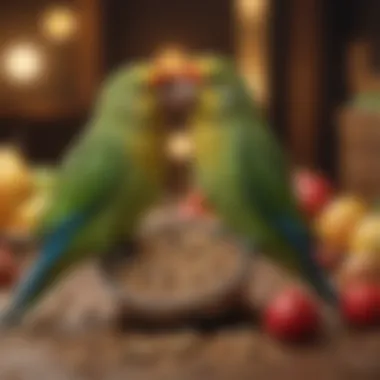
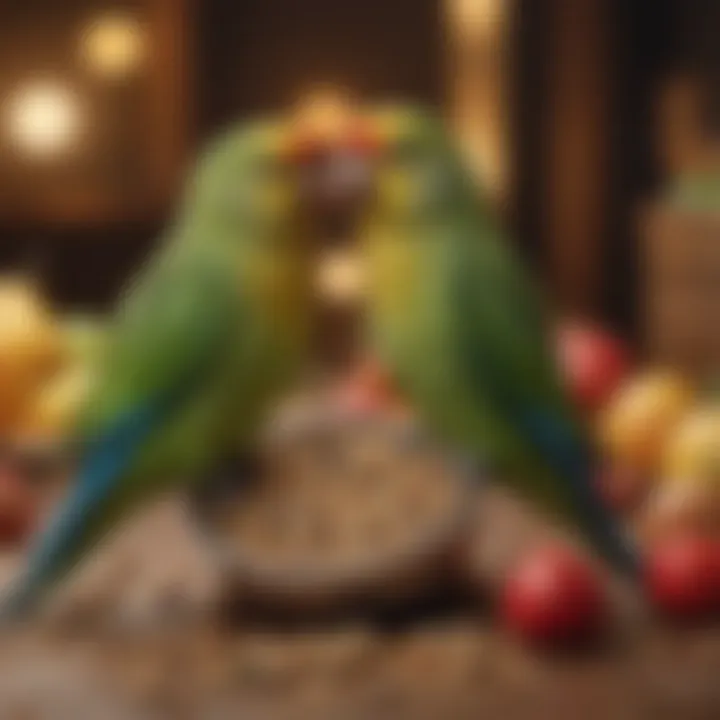
Learning Abilities
Learning abilities are a significant aspect of parakeet intelligence. Parakeets have remarkable memories and can learn tricks or commands quite effectively. This key characteristic showcases their adaptability and eagerness to engage with their environment. Owners can harness this ability by providing a variety of training exercises that stimulate both body and mind.
The unique feature of their learning capabilities is the way these birds can associate words or actions with rewards, making training sessions both fun and rewarding. The advantage of enhancing their learning process is the strengthening of the human-bird bond. However, it entails a commitment from owners to invest time and patience; inconsistency can lead to confusion and frustration on both ends.
Problem-Solving Skills
Problem-solving skills in parakeets indicate a higher level of cognitive function rarely seen in other pet birds. Their ability to overcome challenges is indicative of their intelligence. The key characteristic here is how parakeets exhibit curiosity; they are naturally inclined to explore and interact with their surroundings.
A unique feature of this cognitive trait is demonstrated through tasks like overcoming obstacles to reach a food reward. This knack for finding solutions not only fulfills their instinctual needs but also serves as an excellent outlet for their energy. The advantage is evident in a more content and well-adjusted bird. However, if these skills aren’t properly channeled, they might resort to destructive behaviors, making it essential for owners to provide adequate stimulation and challenges.
Understanding these behavioral characteristics is essential for fostering a harmonious and enriching life for parakeets. By catering to their social and cognitive needs, owners will nurture happier, healthier birds.
Nutrition and Diet
Nutrition plays a pivotal role in the overall health and well-being of parakeets. A balanced diet not only supports their physical health but also contributes to their mental and emotional stability. Mismatched dietary practices can lead to various health issues, affecting everything from their plumage quality to their general vitality. Therefore, understanding the nutritional needs of parakeets is essential for any owner looking to ensure a long and flourishing life for their feathered companions.
Essential Nutritional Needs
Parakeets, like any other pets, need a carefully curated diet that meets their essential nutritional requirements. It's not just about filling the food bowl; it's about providing a comprehensive mix that includes crucial nutrients. Parakeets generally require a mix of protein, carbohydrates, fats, vitamins, and minerals to perform at their best.
- Proteins are vital for tissue repair and muscle development. Sources can include seeds, legumes, and grains.
- Carbohydrates provide energy and can be obtained from fruits and vegetables as well as grains.
- Fats from sources such as nuts are essential for overall health, but should be given moderately due to their high-calorie content.
- Vitamins and Minerals are crucial for metabolic functions. Fresh fruits and vegetables can help supply these crucial elements.
Creating a Balanced Diet
A well-rounded diet for parakeets includes a variety of foods, ensuring that they get all the nutrients they require. Two primary food categories are often considered: Seeds and Pellets and Fresh Fruits and Vegetables.
Seeds and Pellets
Seeds form the traditional diet for many bird species, and they continue to be staple for parakeets. Typical seed mixes for parakeets often contain small amounts of millet, canary seed, and sunflower seeds. However, they are often high in fat and low in some essential nutrients. While many owners use seeds, supplements in the form of pellets are gaining traction due to their formulated nature.
- Key Characteristic: Pellets are specially formulated to meet the dietary needs of parakeets, often providing a complete nutritional profile in every bite.
- Unique Feature: Unlike seeds, high-quality pellets ensure that every morsel contains the necessary vitamins and minerals, eliminating the risk of selective feeding by the bird, which is common with seeds.
- Advantages/Disadvantages: While seeds are loved by many parakeets for their taste, relying solely on them can lead to nutritional deficiencies. Pellets, though, may not appeal to every parakeet at first, and transitioning to them might take time. However, the overall health benefits of feeding a predominantly pellet-based diet cannot be overstated.
Fresh Fruits and Vegetables
Incorporating fresh fruits and vegetables is crucial for any parakeet's diet. These not only provide additional nutrients but also keep mealtime interesting for your bird.
- Key Characteristic: Fresh produce is rich in vitamins, particularly Vitamin A and C, which are crucial for a parakeet's immune function and general health.
- Unique Feature: Fresh fruits and vegetables are less energy-dense than seeds, making them a great option for promoting a healthy weight.
- Advantages/Disadvantages: While fresh produce is essential for a balanced diet, they can spoil quickly and require more effort in preparation. Some fruits, like avocados, can be toxic to birds, so it’s important to do your research before feeding them.
"A balanced diet ensures that your parakeet not only survives but thrives, making it an essential aspect of responsible pet ownership."
Making sure your parakeet enjoys a nutritious and varied diet is part of the key to keeping them happy and healthy. With a little effort and planning, your feathered friend can enjoy a meal fit for a king.
Housing Requirements
The housing requirements for parakeets are essential for their physiological and emotional well-being. A proper environment not only caters to their physical needs but also impacts their behavior and overall happiness. Understanding what constitutes a suitable living space is critical for every parakeet owner. Here, we will explore optimal cage setups, as well as the importance of enrichment and play within their habitat, ensuring these delightful birds remain active, healthy, and engaged.
Optimal Cage Setup
An appropriate cage setup acts as the foundation for a parakeet's life. The dimensions of the cage matter greatly; a larger space is always better as it allows for movement and exploring. Ideally, a cage should be at least 18 inches wide, 18 inches deep, and 24 inches high, though larger habitats are more beneficial. Vertical space is particularly important, allowing parakeets to exercise their natural penchant for climbing.
Cages with horizontal bars provide better opportunities for climbing and play. When selecting a cage, ensure the bar spacing is no more than 0.5 inches apart to prevent escapes or injuries. It's best to avoid cages that are too narrow or cramped, as this may result in stress or aggressive behaviors.
Another critical element is the cage’s placement. Cages should not be located in high-traffic areas where noise and sudden movements can frighten the birds. Instead, they prefer a cozy location that allows them to observe their surroundings without feeling threatened. Moreover, adding a cover to the cage during nighttime can help the parakeets feel secure and rest well.
Enrichment and Play
Providing a well-enriched environment is crucial for the happiness and health of parakeets. Just like us, they thrive on mental stimulation and physical activity. Boredom can lead to undesirable behaviors, such as feather plucking or excessive screeching. This is why it’s paramount to incorporate various forms of entertainment into their habitat.
Perches and Toys
When it comes to perches, variety is the spice of life. Offering different types of perches, such as natural wood branches, rope, and soft perches contributes greatly to their foot health. The rough texture of natural woods helps to naturally wear down their nails, which is necessary for their well-being.
Toys also serve a significant purpose in their daily routine. They encourage physical activity and mental engagement. For instance, toys that can be shredded or those that require manipulation are particularly popular among parakeets. The key characteristic of quality bird toys includes their durability and variety; with options ranging from hanging toys to foraging puzzles that challenge their cognitive abilities. Incorporating these elements helps to stave off the monotonous boredom that can be detrimental to their health. However, always ensure that toys are made from bird-safe materials to prevent any toxic exposure.
Social Interaction
Social interaction plays a pivotal role in the health of parakeets. These birds inherently thrive in social environments, often forming strong bonds with their human caretakers and other birds. By spending quality time with your parakeet, whether through gentle talking, supervised playtime outside the cage, or training sessions, you greatly enhance their emotional well-being.
Parakeets are inherently curious and enjoy companionship; hence introducing them to different activities enriches their lives. Moreover, allowing them interaction with other parakeets under careful supervision can also stimulate their social behaviors. This leads to a fulfilling life where they can express their natural tendencies and build strong social bonds.
Remember that an engaged parakeet is a happy parakeet. Make sure to regularly change up their playtime routine and cage environment to keep them on their toes!
Creating a blend of physical space, enrichment, and social opportunity forms the basis for a harmonious living environment for parakeets. A well-thought-out housing arrangement can contribute substantially to the well-being of these charming little companions.
Health and Wellness
Caring for a parakeet goes beyond providing food and a cage; health and wellness are crucial elements in ensuring these lively creatures live long and vibrant lives. Just like any pet, parakeets require attention to various health factors including regular check-ups, proper diet, and observation of their behavior. Keeping these birds healthy not only ensures their well-being but also makes for a joyous companionship. Ignoring health concerns can lead to serious consequences, often culminating in unnecessary suffering and possibly premature loss. Thus, an understanding of common ailments and preventative measures is essential.
Common Health Issues
Respiratory Problems
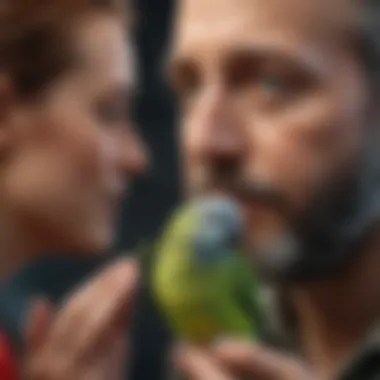
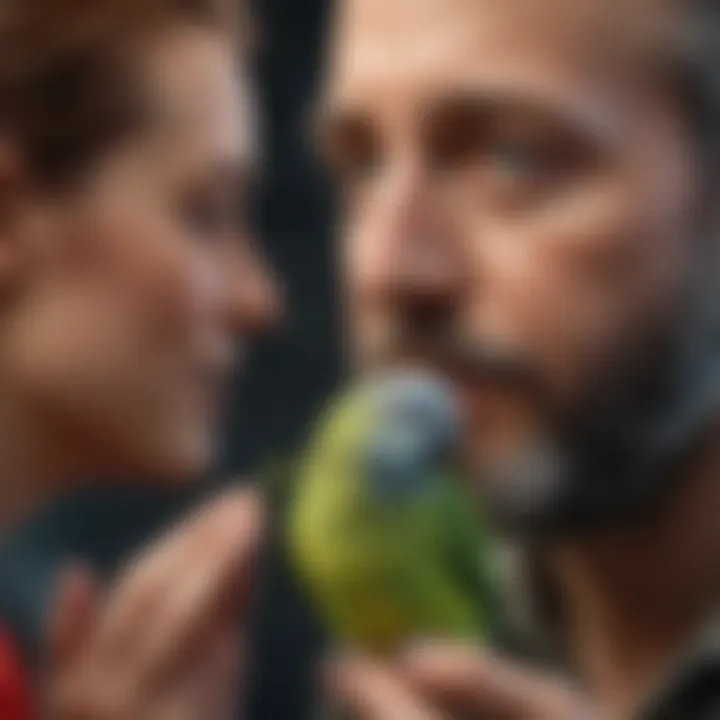
Respiratory problems are some of the most commonly encountered health issues in parakeets. These can stem from poor air quality, exposure to smoke or dust, and even respiratory infections caused by bacteria or viruses. A key characteristic of these issues is that they often present subtle symptoms early on, which can be easily overlooked by owners too busy to notice slight changes in their bird’s behavior.
For instance, if you notice your parakeet sneezing more often or displaying unusual breathing sounds, it might indicate a deeper problem. Addressing these respiratory concerns promptly holds significance in maintaining the overall well-being of the bird. If left untreated, respiratory issues can escalate quickly, leading to potentially critical health situations.
"An ounce of prevention is worth a pound of cure."
Investing time in ensuring clean living conditions can drastically reduce the chances of these issues developing. It's important to include frequent cleaning of cages, proper ventilation, and avoiding exposure to hazardous fumes. Thus, being proactive about respiratory health not only benefits the bird but can also enhance the relationship between the pet and its owner.
Nutritional Deficiencies
Another crucial health aspect revolves around nutritional deficiencies. Where diet is concerned, parakeets require a balanced intake of seeds, fresh fruits, vegetables, and even some commercial pellets. Sometimes, owners may not realize that a lack of essential nutrients can lead to problems like poor feather quality, lethargy, and even more serious issues like liver disease. This makes understanding nutrition particularly critical.
A key feature of nutritional deficiencies is the wide-ranging implications they can have on a bird’s overall health. For example, insufficient calcium can lead to serious bone problems, while a lack of vitamin A might result in issues related to vision and immune function. Such deficiencies are often preventable through awareness and simple dietary adjustments. Engaging in research and consulting avian veterinarians when establishing meal plans could greatly enhance the bird’s quality of life.
Preventative Care
Regular Vet Visits
Regular veterinary visits are indispensable in maintaining a parakeet's health and wellness. These check-ups help catch potential health problems before they escalate into serious concerns. A distinctive characteristic of these vet visits is how they provide owners with valuable insights specific to their bird's health, from examinations to vaccinations.
Establishing a routine of vet check-ups is a proactive approach that is vital for the longer-term health of parakeets. A vet can conduct a thorough health check, assess any behavioral changes, and spot potential issues early on, saving both time and possible distress down the line. While it might seem tedious for some owners, such regular check-ups are indeed beneficial and can foster a deeper trust between the owner and the pet.
Grooming Essentials
Grooming essentials, though often seen as a cosmetic task, play a critical role in a parakeet's overall wellness. Regular grooming helps maintain feather quality and can prevent unnecessary complications like feather plucking. Keeping nails trimmed and beaks properly shaped not only enhances a bird’s appearance but also prevents injury and promotes healthy habits.
Moreover, grooming can be an opportunity to observe the bird closely for any signs of health issues. Owners may find unexpected lumps, changes in feather quality, or other anomalies that may require attention. This creates a small yet significant chance for early intervention. While grooming can be demanding and may require some skill, the benefits are undeniable, making it an essential component of proper parakeet care.
In the end, attention to health and wellness is not just beneficial; it’s a fundamental commitment that every parakeet owner should embrace. By remaining vigilant about respiratory issues, nutritional needs, regular vet visits, and grooming practices, owners position themselves to ensure that their feathery companions lead happy and healthy lives.
Breeding and Reproduction
Breeding and reproduction are not just processes; they are essential elements that shape the lives of parakeets. Understanding these aspects is vital for bird owners and breeders alike, as they directly impact the health and happiness of the birds. Emphasizing proper breeding techniques can lead to stronger, more vibrant chicks, while neglect can result in a range of problems including health issues or genetics defects. As such, this section will explore the intricacies of parakeet breeding, their behavior during mating, and how to effectively care for their young.
Breeding Behavior
Breeding behavior in parakeets can be as fascinating as it is essential. These birds often engage in elaborate courtship rituals that may involve singing, head-bobbing, and even gentle preening. It’s a lively affair, often resembling a dance, where both male and female birds participate actively.
It's important to note that this behavior can vary widely among species. For instance, Budgerigars may display a more straightforward approach, focusing on vocal songs and simple displays. In contrast, Indian Ringnecks might engage in more visually striking courtship, with males showcasing their vibrant plumage.
"Breeding rituals are critical; they reinforce social bonds and establish territory, ultimately leading to successful mating."
A key factor in breeding behavior is environment. A secure and comfortable space encourages parakeets to engage in these behaviors openly. Providing adequate nesting sites and a peaceful atmosphere can make a world of difference. Timing is also crucial; while some breeds can start breeding at a young age, waiting until they are well-matured is often beneficial for the health of both the parents and the chicks.
Care of Chicks
Caring for unweaned parakeet chicks requires a tender touch, keen attention, and some experience. When parakeets successfully mate, the care of the chicks becomes a top priority, and understanding the needs of both the parents and their offspring is crucial.
Nesting Requirements
Nesting is a fundamental part of breeding and has specific needs worth exploring. Parakeets typically prefer to nest in tree hollows in the wild, leading to a preference for enclosed spaces in captivity too. A cozy nest box made from untreated wood is a well-accepted choice. This choice contributes to a sense of security for the parents and little ones.
The nest box should be well-ventilated but also sheltered from direct drafts. A good nesting material generally includes grass and shredded paper for softness. A solid nesting setup not only provides insulation but also minimizes stress during the incubation period. An essential factor in nesting is cleanliness. Regularly cleaning the nesting area can help reduce the risk of infections or parasites.
A unique feature to consider is the size and shape of the nesting box. For example, a wider box may allow for more comfortable positioning for both parents and chicks, while a taller design gives additional vertical space for young birds to perch as they grow.
Feeding Newborns
Feeding newborn parakeets can be tricky but it's critical for their development. Typically, the mother will provide regurgitated food rich in essential nutrients. This parental feeding is beneficial because it not only nurtures the chicks but also helps them build a bond. It’s observed that in captivity, hand-feeding can also be a suitable method if done properly.
An essential characteristic of feeding newborns is understanding their dietary needs profoundly. For young chicks, formulas specifically designed for hand-rearing such as formulated chick food are often recommended. These formulas provide the necessary balance of proteins, fats, and vitamins that young parakeets need to thrive. However, overfeeding is a common issue, which can lead to health risks or underdeveloped chicks.
A unique aspect of feeding newborns is the frequency of feedings; very young chicks may require feeding every 2-3 hours. As they grow and become more self-sufficient, this can gradually reduce. Careful timing and the right amounts are crucial to navigate this phase effectively.
Culmination: Caring for Your Parakeet
Caring for your parakeet is more than just a passing interest; it demands a thoughtful approach and a deeper understanding of these sociable creatures. As pet owners, knowing how to create the right environment and fostering meaningful connections not only enriches the lives of these birds but also enhances the fulfillment we, as humans, derive from our avian companions.
Creating a Harmonious Environment
Creating a harmonious environment for your parakeet starts with the right cage setup. It's essential to choose a spacious cage that allows your bird to move freely. Incorporate various perches of different thicknesses to promote their foot health and agility. Ensure that the cage is placed in a lively area of your home, where your parakeet can interact with the family. This way, your feathered friend can feel included, rather than isolated.
Incorporating stimulation into their habitat is equally important. Adding toys that encourage problem-solving or dexterity can ward off boredom and keep your parakeet mentally healthy. Durable bells, for instance, can provide auditory stimulation and encourage exploration. Just remember, variety is the spice of life; rotating toys not only keeps things fresh but also offers novel experiences to your parakeet.
Don't forget about the diet. A diverse diet that includes pellets, fresh fruits, and veggies plays a major role in their overall well-being. Setting up a feeding routine can help maintain healthy eating habits while avoiding overindulgence.
"You can tell a lot about a bird by how it interacts with its surroundings. A happy parakeet is like a little beacon of joy in your home!"
The Importance of Social Bonds
Parakeets are, by nature, social creatures. This trait should be embraced in their care routine. Building strong bonds with your parakeet can lead to a harmonious relationship. Spending time talking to or playing with them daily fosters trust and companionship.
It's crucial to understand that some parakeets may have differing social needs. While some might thrive on constant interaction, others may prefer a little personal space. It’s a balancing act that requires some observation and patience. Notice their body language; feathers ruffled can suggest annoyance, while a relaxed stance may indicate comfort.
When considering adding a second parakeet to your environment, ponder the dynamics of their relationship. They can be great companions for each other, fulfilling innate social needs. However, proper introductions are key, as hostile encounters can lead to unnecessary stress.
In sum, caring for your parakeet involves creating not just a physical space, but a life filled with mental and social stimulation. As you integrate these principles into their care, you will inevitably notice a happier, healthier bird, which makes any efforts worthwhile.
By prioritizing your parakeet's environment and social interactions, you not only enhance their quality of life but also deepen your bond with these feathered friends.















